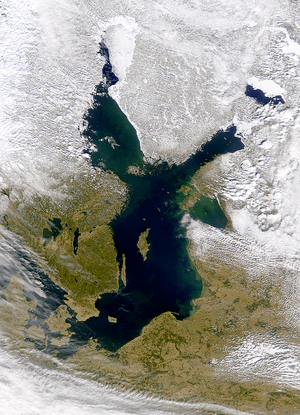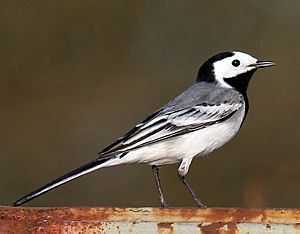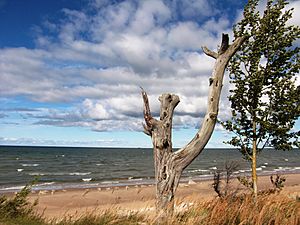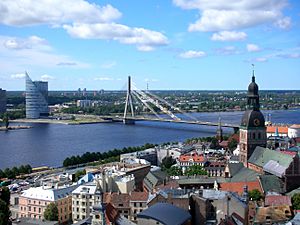Latvia facts for kids
Quick facts for kids
Republic of Latvia
|
|
|---|---|
|
|
|
|
Anthem: Dievs, svētī Latviju! (Latvian)
("God Bless Latvia!") |
|
![Location of Latvia (dark green)– on the European continent (green & dark grey)– in the European Union (green) — [Legend]](/images/thumb/3/32/EU-Latvia.svg/350px-EU-Latvia.svg.png)
Location of Latvia (dark green)
– on the European continent (green & dark grey) |
|
| Capital and largest city
|
Riga 56°57′N 24°6′E / 56.950°N 24.100°E |
| Official languages | Latviana |
| Recognized languages | Livonian Latgalian |
| Ethnic groups
(2022)
|
|
| Religion
(2018)
|
|
| Demonym(s) | Latvian |
| Government | Unitary parliamentary republic |
| Edgars Rinkēvičs | |
| Evika Siliņa | |
|
• Speaker of the Saeima
|
Daiga Mieriņa |
| Legislature | Saeima |
| Independence | |
|
• Declared
|
18 November 1918 |
|
• Recognised
|
26 January 1921 |
|
• Constitution adopted
|
7 November 1922 |
|
• Restored
|
21 August 1991 |
| Area | |
|
• Total
|
64,589 km2 (24,938 sq mi) (122nd) |
|
• Water (%)
|
2.09 (2015) |
| Population | |
|
• 2022 estimate
|
1,842,226 (146th) |
|
• Density
|
29.6/km2 (76.7/sq mi) (147th) |
| GDP (PPP) | 2024 estimate |
|
• Total
|
|
|
• Per capita
|
|
| GDP (nominal) | 2024 estimate |
|
• Total
|
|
|
• Per capita
|
|
| Gini (2021) | ▲ 35.7 medium |
| HDI (2022) | very high · 37th |
| Currency | Euro (€) (EUR) |
| Time zone | UTC+2 (EET) |
|
• Summer (DST)
|
UTC+3 (EEST) |
| Calling code | +371 |
| ISO 3166 code | LV |
| Internet TLD | .lv |
Latvia is a country in Northern Europe. Its capital city is Riga. Latvia is one of the three Baltic states, along with Estonia to the north and Lithuania to the south. To the east, Latvia shares borders with Russia and Belarus. The country is divided into four main regions: Kurzeme, Vidzeme, Zemgale, and Latgale.
People from Latvia are called Latvians. They speak the Latvian language. This language is similar to Lithuanian, but they are not close enough for speakers to understand each other easily.
Contents
Latvia's Story: A Brief History
Latvia was first settled by Baltic tribes thousands of years ago. These early people mainly fished, hunted, and traded goods.
Around the late 1100s, German traders and crusaders arrived in Latvia. This led to Latvians losing control of their land. For the next 800 years, different groups like Germans, Danes, Swedes, Poles, and Russians took over Latvia. Finally, in 1918, Latvia became an independent country.
During World War II, the Soviet Union invaded Latvia. Many Latvians were killed or sent far away to places like Siberia. The Soviet Union occupied Latvia again until 1991. When the Soviet Union broke apart, Latvia became an independent country once more.
Exploring Latvia's Geography

Latvia is located in Northern Europe. It lies on the eastern shores of the Baltic Sea. The country covers an area of about 64,559 square kilometers. Most of this area is land, with forests and farmland.
Latvia's total border length is 1,866 kilometers. Its land borders stretch for 1,368 kilometers. It shares borders with Estonia (north), Russia (east), Belarus (southeast), and Lithuania (south). The coastline along the Baltic Sea is 498 kilometers long. It shares this sea border with Estonia, Sweden, and Lithuania.
Most of Latvia's land is less than 100 meters above sea level. The largest lake is Lubāns, covering 80.7 square kilometers. The deepest lake, Drīdzis, is 65.1 meters deep. The longest river entirely within Latvia is the Gauja, at 452 kilometers. The Daugava is the longest river flowing through Latvia, with 352 kilometers of its total 1,005 kilometers in Latvia. Latvia's highest point is Gaiziņkalns, which is 311.6 meters high. The shallow Gulf of Riga is an inlet of the Baltic Sea in the northwest.
Latvia's Climate
Latvia has a temperate climate. This means it has four distinct seasons. Some describe it as a Humid continental climate, while others call it an oceanic climate.
Areas near the coast, especially the western part of the Courland Peninsula, have cooler summers and milder winters. Eastern parts of Latvia have warmer summers and colder winters.
Latvia's Natural Environment
Much of Latvia is made up of fertile plains and gentle hills. The landscape often shows a mix of large forests, fields, farms, and pastures. Farmland has birch trees and small wooded areas. These provide homes for many plants and animals. Latvia also has hundreds of kilometers of natural coastline. It is lined with pine forests, sand dunes, and white sand beaches.
Latvia has the fifth highest amount of forest land in the European Union. Forests cover about 56% of the country's total land area.
Latvia has over 12,500 rivers, stretching for 38,000 kilometers. Important rivers include the Daugava River, Lielupe, Gauja, Venta, and Salaca. The Salaca is a major place for salmon to lay their eggs in the eastern Baltic region. There are 2,256 lakes larger than 1 hectare. These lakes cover a total area of 1,000 square kilometers. Mires (wetlands) cover 9.9% of Latvia. Many of these mires are untouched by people. They are safe places for many rare plants and animals.
Farmland makes up about 29% of Latvia's land. After collective farms were ended, the amount of land used for farming decreased. Now, most farms are small. About 200 farms practice "ecologically pure farming." This means they do not use artificial fertilizers or pesticides.
Latvia has several national parks:
- Gauja National Park in Vidzeme (since 1973)
- Ķemeri National Park in Zemgale (1997)
- Slītere National Park in Kurzeme (1999)
- Rāzna National Park in Latgale (2007)
Amazing Plants and Animals

About 30,000 different kinds of plants and animals have been found in Latvia. Common wildlife includes deer, wild boar, moose, lynx, bears, foxes, beavers, and wolves.
Some animals that are rare in other European countries are common in Latvia. These include:
- Black stork
- Corncrake
- Lesser spotted eagle
- White-backed woodpecker
- Eurasian crane
- Eurasian beaver
- Eurasian otter
- European wolf
- European lynx
Latvia is mostly covered by forests, especially Scots pine, birch, and Norway spruce trees.
Several plants and animals are national symbols of Latvia:
- The Oak and linden trees are Latvia's national trees.
- The daisy is its national flower.
- The white wagtail is Latvia's national bird.
- The two-spot ladybird is its national insect.
- Amber, which is fossilized tree resin, is also a very important cultural symbol. In ancient times, amber from the Baltic Sea coast was highly valued by Vikings and traders. This led to the creation of the Amber Road, a trade route.
Nature reserves in Latvia protect beautiful landscapes and many large animals. At Pape Nature Reserve, animals like European bison, wild horses, and recreated aurochs have been brought back. Now, many large animals that lived there long ago, such as moose, deer, and wolves, can be found there again.
People and Languages of Latvia
Ethnic Groups in Latvia
Latvia has been home to many different groups of people for centuries. However, the population changed a lot in the 20th century. This was due to the World Wars, people moving away, and the Soviet Union's occupation. In 1897, Latvians made up 68.3% of the population. Other groups included Russians, Jews, Germans, and Poles.
Languages Spoken in Latvia
The only official language in Latvia is Latvian. It belongs to the Baltic language family. Another important language is Livonian, which is almost extinct. It is protected by law. Latgalian is also protected as a historical variation of Latvian.
Russian was widely spoken during the Soviet era. It is still the most common minority language today. About 34% of people speak Russian at home.
All students in Latvia must learn Latvian. Most schools also teach English and either German or Russian. English is widely used, especially in business and for tourists. As of 2014, there were 109 schools for minority groups. In these schools, 40% of subjects are taught in Russian, and 60% are taught in Latvian.
Latvian Culture and Traditions
Latvian folklore, especially its traditional songs and dances, is very old. It goes back over a thousand years. More than 1.2 million folk song texts and 30,000 melodies have been recorded.
From the 1200s to the 1800s, Baltic Germans were the upper class in Latvia. They had their own culture, which mixed Latvian and German influences. However, most native Latvians were peasants. They kept their local pagan traditions alive. These traditions sometimes blended with Christian customs. For example, one popular celebration is Jāņi. This is a pagan festival for the summer solstice, celebrated on the same day as St. John the Baptist's feast day.
In the 1800s, Latvian nationalist movements began. They worked to promote Latvian culture. This time is often seen as a golden age for Latvian culture. Posters from this period show influences from other European cultures.
The Latvian Song and Dance Festival is a very important cultural event. It has been held since 1873, usually every five years. About 30,000 performers take part. They mostly sing folk songs and classical choir songs without instruments. Recently, modern popular songs have also been added.
During the Soviet era, Latvian artists were told to follow a style called "socialist realism." Music became very popular in the 1980s. Songs often made fun of Soviet life and focused on keeping Latvian identity strong. This helped lead to protests against the Soviet Union. Since Latvia became independent, theater, choir music, and classical music have become very important parts of Latvian culture.
In July 2014, Riga hosted the 8th World Choir Games. Over 27,000 singers from more than 450 choirs and 70 countries participated. This festival is the largest of its kind in the world. It happens every two years in a different city.
Delicious Latvian Food
Latvian food usually includes farm products, with meat in most main dishes. Fish is also common because Latvia is on the Baltic Sea. Latvian cooking has been influenced by nearby countries. Common ingredients are found locally, such as potatoes, wheat, barley, cabbage, onions, eggs, and pork. Latvian food is generally quite rich and uses few spices.
Grey peas and ham are considered traditional Latvian foods. Sorrel soup is also popular. Rupjmaize is a dark bread made from rye. It is considered a national staple.
Latvia's Government and Global Role
In Copenhagen on December 13, 2002, Latvia and nine other countries were invited to join the European Union. On September 20, 2003, Latvians voted on whether to join. Two-thirds of Latvians voted yes. On May 1, 2004, Latvia officially became a member of the EU.
Latvia has also been a member of NATO since March 29, 2004. NATO is a military alliance that helps keep its member countries safe.
Related pages
Images for kids
-
Venta Rapid in Kuldīga is Europe's widest waterfall and a natural monument.
-
Devonian sandstone cliffs in Gauja National Park, Latvia's largest and oldest national park.
-
Turaida Castle near Sigulda, built in 1214.
-
The Swedish Empire (1560–1815). Riga became the capital of Swedish Livonia.
-
Jānis Čakste (1859–1927), Latvia's first president.
-
Red Army soldiers in front of the Freedom Monument in Riga in 1944.
-
A reconstruction of a Gulag shack at the Museum of the Occupation of Latvia, Riga.
-
Barricade in Riga to prevent the Soviet Army from reaching the Latvian Parliament in July 1991.
-
Latvia became a member of the European Union in 2004 and signed the Lisbon Treaty in 2007.
-
The Port of Ventspils is one of the busiest ports in the Baltic states.
See also
 In Spanish: Letonia para niños
In Spanish: Letonia para niños



























